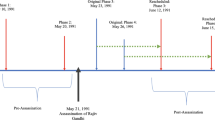Abstract
In this article, criticality within a voting game is rigorously defined and examined. Criticality forms the basis of the traditional voting power measures frequently employed to analyse voting games; therefore understanding criticality is a pre-requisite to understanding any such analysis. The concept of criticality is extended to encompass games in which players are allowed to express multiple levels of approval. This seemingly innocuous extension raises some important questions, forcing us to re-evaluate exactly what it means to be critical. These issues have been largely side-stepped by the main body of research as they focus almost exclusively on ‘yes/no’ voting games, the so called single level approval voting games. The generalisation to multilevel approval voting games is much more than just a theoretical extension, as any single level approval game in which a player can abstain is in effect a multilevel approval voting game.
Similar content being viewed by others
References
Banzhaf J (1965) Weighted voting doesn’t work: a mathematical analysis. Rutgers Law Rev 19: 317–342
Banzhaf J (1968) One man, 3.312 votes: a mathematical analysis of the electoral college. Villanova Law Rev 13: 304–332
Das S (2008) Class Conditional Voting Probabilities. PhD thesis, Birkbeck College, University of London
Felsenthal D, Machover M (1998) The measurement of voting power. Edward Elgar, Cheltenham
Felsenthal D, Machover M (2000) Enlargement of the EU and weighted voting in its Council of Ministers. Technical report, London School of Economics.
Felsenthal D, Machover M (2001) The treaty of Nice and qualified majority voting. Soc Choice Welf 18(3): 431–464
Freixas J, Zwicker W (2003) Weighted voting, abstention and multiple levels of approval. Soc Choice Welf 21: 399–431
Gelman A, Katz J, Bafumi J (2003a) Standard voting power indexes don’t work: an empirical analysis. Social science working paper, California Institute of Technology
Gelman A, Katz J, Tuerlinckx F (2003b) The mathematics and statistics of voting power. Social science working paper 1141, California Institute of Technology.
Johnston R (1978) On the measurement of power: some reactions to Laver. Environ Plan A 10: 907–914
Laver M (1978) On Johnston on Laver on Johnston. Environ Plan A 10: 959–960
Leech D (2002a) Designing the voting system for the EU Council of Ministers. Public Choice 113: 437–464
Leech D (2002b) Shareholder voting power and ownership control of companies. Homo Oecon XIX(3): 345–373
Leech D (2003a) Incentives to corporate governance activism. In: Waterson M (eds) Competition, monopoly and corporate governance, essays in honour of Keith Cowling. Edward Elgar, Cheltenham
Leech D (2003b) Computing power indices for large voting games. Manag Sci 49: 831–838
Leech D (2003c) Power indices as an aid to institutional design: the generalised apportionment problem. In: Holler M, Kliemt H, Schmidtchen D, Streit M (eds) Yearbook on new political economy, vol 22. Mohr Siebeck, pp 107–121
Lindner I (2008) A special case of Penrose’s limit theorem when abstention is allowed. Theory Decis 64(4): 495–518
Mann I, Shapley L (1960) Values of larges games IV: evaluating the electoral college by montecarlo techniques. Technical Report RM-2651, The Rand Corporation, Santa Monica
Paterson I (2006) Voting power derives from the poll distribution—shedding light on contentious issues of weighted votes and the constitutional treaty. Technical Report IHS Economics Series 187, Institute for Advanced Studies, Vienna.
Penrose L (1946) The elementary statistics of majority voting. J R Stat Soc 109: 53–57
Saari D (2001) Decisions and Elections. Cambridge University Press, Cambridge
Shapley L, Shubik M (1954) A method for evaluating the distribution of power in a committee system. Am Political Sci Rev 48: 787–792
Straffin P (1977) Homogeneity, independence and power indices. Public Choice 30: 107–118
Straffin P (1978) Probability models for power indices. In: Ordeshook P (eds) Game theory and political science. New York University Press, New York, pp 477–510
Author information
Authors and Affiliations
Corresponding author
Rights and permissions
About this article
Cite this article
Das, S. Criticality in games with multiple levels of approval. Soc Choice Welf 37, 373–395 (2011). https://doi.org/10.1007/s00355-010-0488-z
Received:
Accepted:
Published:
Issue Date:
DOI: https://doi.org/10.1007/s00355-010-0488-z




